The Department of Environmental and Physical Sciences has established an outdoor laboratory dedicated to sustainability. Not only does this space demonstrate sustainable energy, food production and transport technologies, it also facilitates in teaching students the principles of sustainability through hands-on applications. The sustainability site has also allowed the Shepherd community to take meaningful steps toward a more sustainable future.

Shepherd University DEPS Sustainability Site with Byrd Science and Technology Center in the Background
Sustainable Energy
The sustainability site is equipped with a total of 5 kW of renewable energy generation capacity. All of this capacity is grid-tied via a net meter providing clean energy to the grid when not utilized on site.
The Barn Rooftop PV Array (1.3 kW)
The sustainability site barn is wired to function completely off grid, if necessary utilizing a small DC battery bank to provide emergency power. All of the photovoltaic (PV) modules in this array are connected to a central inverter.
- 6 Evergreen 110 W Polycrystalline Silicone Modules
- 4 BP 160 W Polycrystalline Silicone Modules
- Outback charge controller and inverter
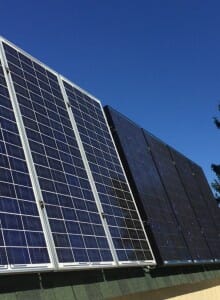
Barn rooftop PV modules
The Pole-Mount Microinverter PV Array (1.9 kW)
The sustainability site pole-mount PV array demonstrates a significant advance in modern PV technology: microinverters. Each module is accompanied by its own dedicated DC-to-AC microinverter that conditions the current on the spot, making it grid compatible. All of these individual inverters are wired in parallel making the array more robust, in the event that an individual module produces less power due to partial shading or malfunction. When panels are wired in series like our barn array, a malfunction or shading of one panel diminishes the performance of the entire array, like a faulty bulb in a string of Christmas lights. The microinverters also allow the production and performance of each individual module to be monitored and logged. Green power production from our pole-mount array is available for online viewing (see link below).
- 8 SolarWorld 235 W Polycrystalline Silicone Modules
- 8 Enphase M215 Microinverters
- Enphase Envoy Datalogger and Gateway (located in barn)
Click here to see production data for this array.
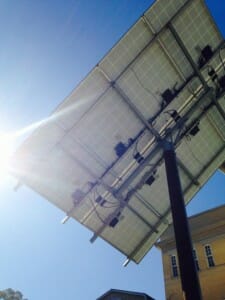
Underside of pole-mount array showing microinverters mounted to each module
Wind Turbine (1.8 kW)
The sustainability site wind turbine is a first generation 3.72-m diameter Skystream mounted on a monopole. The aerodynamic blade design enables this unit to pick-up at remarkably low wind speeds (as low as 8 mph, or 3.5 m/s). The turbine can be lowered on site for inspection and maintenance. The Skystream was designed for homes and businesses and originally came with a grid-tie inverter integrated into its nacelle so that folks could install it and connect directly to their extant electricity service. We recently replaced the integrated inverter with a separate inverter located in the sustainability site barn, where we can monitor performance and service when necessary.
- Skystream 3.7
- NTP Wind Power Inverter Upgrade
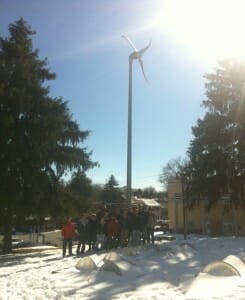
Students and faculty next to wind turbine on a snowy day
Sustainable Food Production
Raised Beds for Organic Agriculture
The sustainability site features 12 raised beds for organic agriculture production. Using ecological growing techniques that conserve water resources, enhance soil life and productivity and eliminate the need for pesticides, we produce a range of salad greens, herbs and vegetables following USDA Organic standards. The bounty is used for catering of IEPS special events and in campus dining facilities. Practices such as crop rotation, diversification, composting, double digging, poly cropping and integrated pest management are applied and taught to students working in the outdoor lab. Flowering insectary plants also are established during summer to assist pollinators and beneficial insects in the ecosystem, providing them nectar resources and pollen free of insecticides or genetically modified organisms.
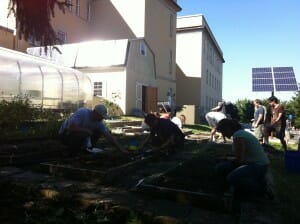
IEPS students working in raised beds
Solar-Thermal Greenhouse
The 18 x 32 foot solar greenhouse at the sustainability site has a novel radiant floor heating system fed by solar thermal collectors. Propylene glycol moving through the collector tubes is warmed as it absorbs solar energy, and this heat is transferred to pex pipes embedded in the greenhouse concrete slab. The heat slowly radiates from the floor up to the plant roots, efficiently providing heat where it is needed. Solar and wind power generated at the sustainability site are used to power greenhouse lighting, pumps and fans. The greenhouse is used to produce organic microgreens and for starting plants used in the raised bed production. It also houses a sustainable aquaponics system.
- 2 Heliodyne GOBI 4×6 flat-plate collectors
- 80 gal Heliodyne solar hot water storage tank
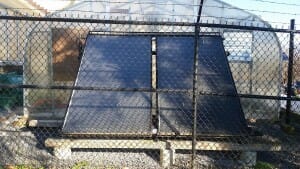
Greenhouse solar-thermal system solar collector
Sustainable Aquaponics System
The sustainability site greenhouse features an innovative sustainable aquaponics system. Aquaculture, or raising food fish in containment, is one of the fastest growing trends in global food production. Our aquaponics system couples aquaculture with hydroponics, or growing vegetables and herbs without soil. Nutrient-laden wastewater can be an environmental issue in traditional aquaculture production when it is removed from the fish tanks and pollutes natural waterways. Our sustainable aquaponics system pumps water containing nutrients from the fish tanks to trays housing hydroponic food production. The plant roots remove the nutrients from the water, utilizing them for growth and cleansing the water that is recycled back to the fish tank. This tightly coupled system is highly sustainable as it eliminates the need for additional water resources, and the coupling of fish and vegetable growth recycles valuable nutrients in vegetable biomass, creating an additional economic benefit for the grower. All system components are food grade and meet organic certification standards. Furthermore, fish feed is vegetable sourced, and no antibiotics are used.
- 2 aquaculture tanks (300 gal each)
- 4 hydroponic troughs (20 ft by 9 in) with 216 plant capacity
- 100 native bluegill
Sustainable Transport
Electric Vehicle Charging Stations
The sustainability site is equipped with three new Schneider EV charging stations that interface with the ChargePoint EV charging station network. These were made possible, in part, by a generous donation by Schneider Electric. Visit the ChargePoint EV Chargers page for more details on how to utilize the chargers.
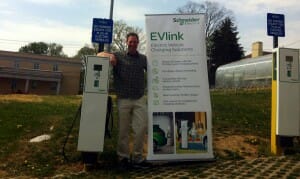
Dr. Groff next to one of the Sustainability Site’s EV charging units. This EVLink cloud connected dual-charging unit was donated by Schneider Electric.
Biodiesel
The sustainability site features a 50 gallon biodiesel processor that enables production of B100 (100% biodiesel) from virgin oils (e.g., canola) or waste vegetable oils generated by cooking facilities. Students have collected cooking oil used at campus dining facilities and converted this via a process known as transesterification to biodiesel that can be used in any vehicle with a diesel engine. This is highly sustainable because the biodiesel displaces fossil fuel diesel and results in lower air emissions relative to fossil fuel diesel. The process also diverts a waste product into a secondary use.
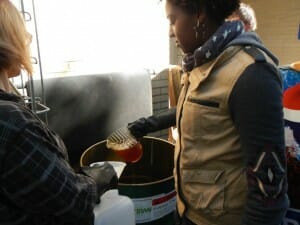
Students collecting waste grease for biodiesel production
Recycling and Repurposing Materials
The sustainability site will soon feature a railing created from repurposed and recycled materials. The railing, designed and built by Shepherd University Sculpture student, Erin Bennett, in 2015-2016, incorporates a sustainability theme with maple seeds infused into the design and is an example of a nearly closed-loop design approach. Aluminum cans collected from campus recycling were smelted using biodiesel that was produced from campus waste vegetable oil. Steel, concrete and sand were sourced from scrap yards and building waste vendors and were repurposed to form the support sections and footers. This project is an exciting campus STEAM collaboration!
History
Originally conceived as a renewable energy demonstration site including the barn and rooftop solar PV system, wind turbine and biodiesel generator, the site was established with funding from a 2005 WV EPSCoR Innovation Grant, as well as generous support from the West Virginia Division of Energy and the Shepherd University Foundation. Over the years, the site has evolved, incorporating additional sustainable living applications and replacing technologies as new ones emerge.
- 2010: the solar greenhouse, radiant heating system and raised gardening beds were constructed for sustainable food production.
- 2013: site expansion included the pole mounted solar array, EV charging systems and permeable parking spaces.
- 2015: the Skystream wind turbine was overhauled and a new external inverter was installed, as well as the monitor display system and web page tracking real-time electricity production by the pole mounted solar PV array.
- 2016: the sustainable aquaponics system was added, and the car chargers were replaced with the latest models of EVlink charging stations that feature a mobile device app for users.
The continued development of the sustainability site over the years has been made possible by the ongoing generous support from the West Virginia Division of Energy, the Shepherd University School of Natural Sciences and Mathematics, and the Department of Environmental and Physical Sciences, as well as the efforts of numerous Shepherd University students and alumnae who have contributed to various installations, conferences and workshops, along with Department of Environmental and Physical Sciences faculty.